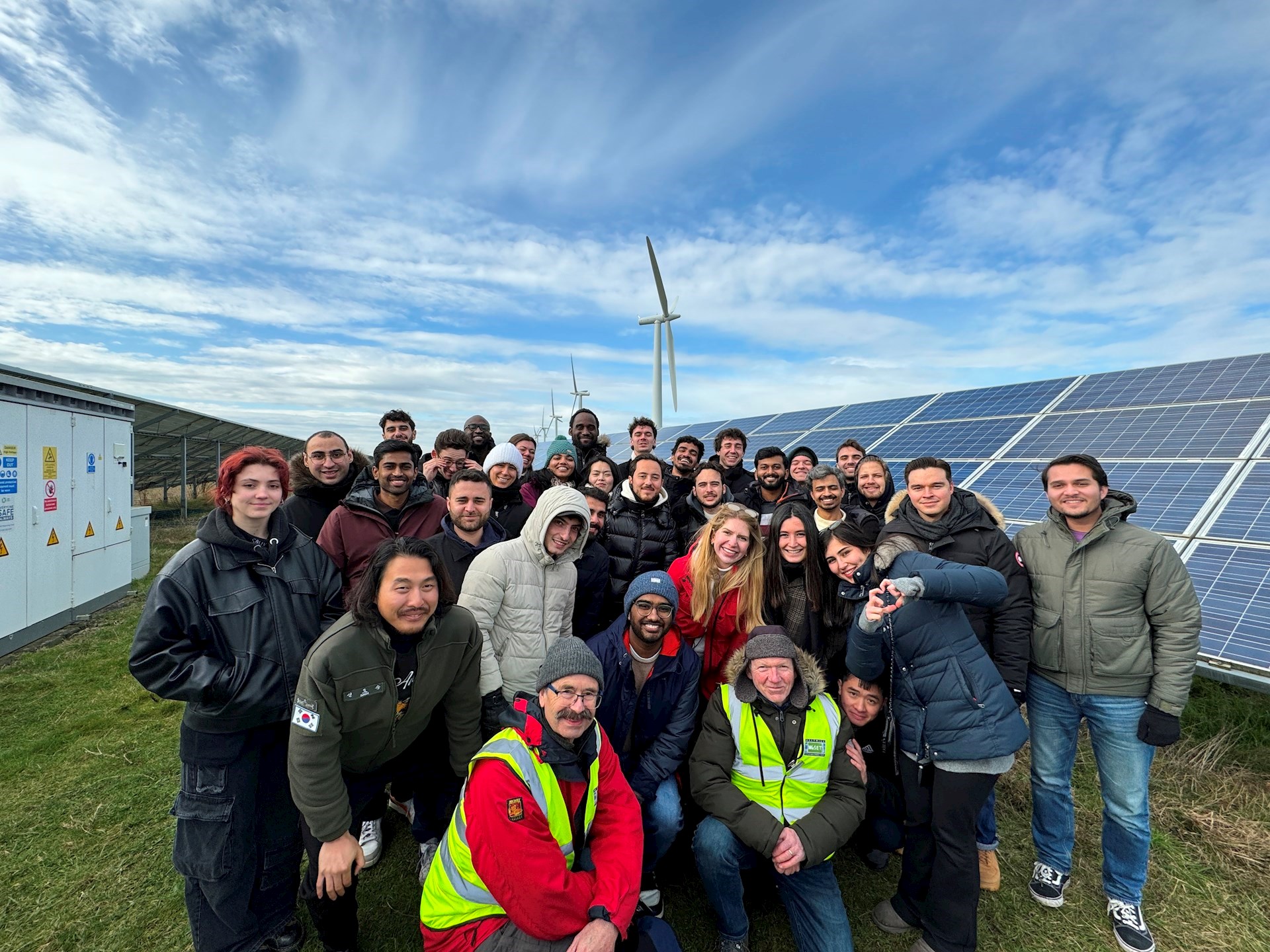Lessons learned from the Westmill Wind Farm and Solar Park
Earlier this year, students from the MSc in Energy Management specialisation visited Westmill Wind Farm and Solar Park – the first 100% community-owned onshore wind farm and solar park in the south of England. The field trip provided participants with key insights into wind and solar technology, the electricity-generation process, operational challenges and benefits, and whether policies support the growth of wind and solar.
The site was the vision of Adam Twine (landowner and farmer), who was inspired by a trip to Denmark where 20% of the country’s renewable energy is owned by communities. It is believed to be the UK’s first and the world’s largest cooperatively run, community-owned solar farm.
Despite the planning process for both the wind farm and solar park taking a whopping 13 years, the aim of fighting climate change by financing sources of renewable energy, providing local households and other stakeholders with a stable, reliable source of income, and helping the area transition to a low-carbon future persevered. At present, the whole project generates electricity for 3,500 households.
The Wind Farm
- It is formed of five turbines, each of which generates 1.3 GWh. These turbines were built in 2008, and are therefore less efficient than today’s equivalent technology- one wind turbine can provide more energy than the five turbines available at Westmill.
- At an early stage, the project faced objections from an anti-wind minority. Eventually, planning consent was secured – a process that took over 10 years.
- Implementation of the project took eight weeks.
- The impact of Brexit on the wind farm operations has brought supply chain challenges as spare parts come from Denmark, leading to difficulties in finding them for old turbine models and an increase in transport costs.
- The wind farm has 2,400 shareholders benefitting from an 8% ROI.
The Solar Park
- The project generates 4.8GWhr/year of clean electricity. This is enough to power 1,600 homes/year, equivalent to every home in nearby Watchfield and Shrivenham.
- 2,000 tons of CO2 emissions are saved annually by the solar park.
- The site consists of 30 acres of over 20,000 polycrystalline PV panels.
- The cost of building the solar park was £15 million. At present, the investment needed to build a site with these characteristics would be around £3.5 million.
- Planning consent for the solar park took under three years.
- The site provides shareholders with a 10% ROI.
Local Community Benefits
- As well as offering local people the opportunity to share in the direct rewards of the project, the site provides a number of associated benefits for the area. These include boosting the local economy by ensuring the profits stay in the area, encouraging visitors and raising the local area’s profile.
- A percentage of the profits go to Westmill Sustainable Energy Trust (WeSet) – a charity set up by members of both Westmill Wind and Solar Cooperatives to spread the benefits of Westmill to the wider community. They carry out a wide range of activities, the core being educational work, local energy conservation and renewable energy initiatives and arts projects.
- Win-win situation: through WeSet, the local community has also benefitted from additional activities such as installing solar panels in the local school and insulation of the village hall.
Takeaways
- Ordinary people can drive positive change! Planning consent might take a long time, but you need to be determined to support the energy transition.
- Consistency of the policy environment is key.
- Successful wind farms involve the local community from the beginning of the project, which is a key factor in making things happen with wind energy. As a result, locals feel proud, and they love to see renewable energy in action.
- Onshore wind and solar are two of the cheapest forms of renewables. It’s inspiring to see the impact of these kinds of projects and how we can implement them across the world in our collective fight against climate change, and to reduce our reliance on fossil fuels.
- These types of projects provide a great opportunity for all who are concerned with the effects of climate change to become involved in the ownership and operation of sites.
Empowering the Energy Transition
“The biggest challenges the energy industry will continue to face are access to resources, access to the relevant equipment, and a shortage of skilled workers that would be needed for the energy transition. Globally, the industry as a whole needs to attract talented people, and reskill the existing workforce for a sustainable future. We are proud to build a greener path with our community and contribute to the greatest shift in the energy system of this century as we observe a rapid acceleration of the energy transition. Through the MSc in Energy Management, we aim to inspire the future generation of leaders in the industry. This specialisation provides the crucial skills, knowledge and practical experience required by the current and, most importantly, future energy-industry job markets,” says Dr Georgia Makridou, Academic Director of the MSc in Energy Management at ESCP Business School and Director of the Energy Management Centre.
“The Westmill Wind Farm and Solar Park visit is one of many examples of how the MSc in Energy Management combines both academic and practical learnings. Following courses in Renewables and Electricity Markets, we gained a clear understanding of how such a facility operates. While interacting with the tour guides, we learned about the real-world challenges involved in building a project that has the local community at its centre. Overall, the site visit was a very memorable experience!” says Stefanos Negris, MSc in Energy Management Student.
Useful links:
ESCP Business School
MSc in Energy Management
ESCP Energy Society









 Facebook
Facebook Linkedin
Linkedin Instagram
Instagram Youtube
Youtube EMC Newsletter
EMC Newsletter







